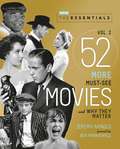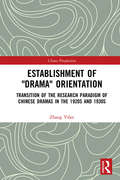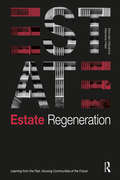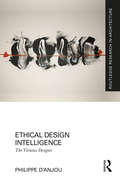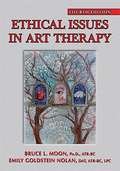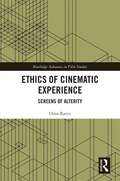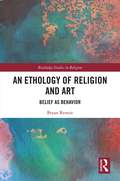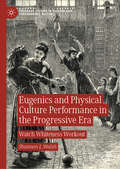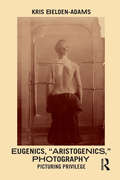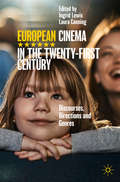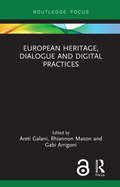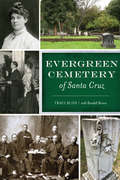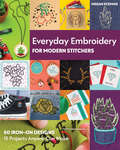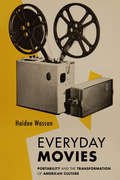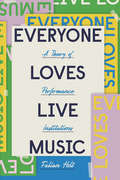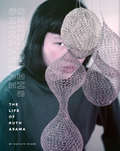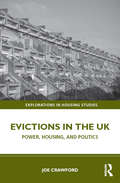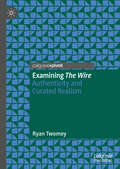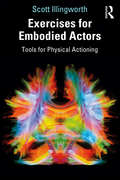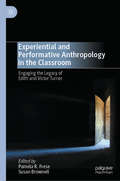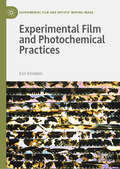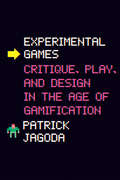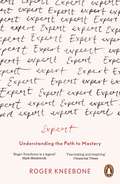- Table View
- List View
The Essentials Vol. 2: 52 More Must-See Movies and Why They Matter (Turner Classic Movies)
by Jeremy Arnold Turner Classic MoviesA guide to fifty-two examples of must-see cinema, The Essentials Vol. 2 -- based on the Turner Classic Movies series -- is packed with behind-the-scenes stories, illuminating commentary, moments to watch for, and hundreds of photos spotlighting films that define what it means to be a classic.Since 2001, Turner Classic Movies' The Essentials has been the ultimate destination for cinephiles both established and new, showcasing films that have had a lasting impact on audiences and filmmakers everywhere. In this second volume based on the series, fifty-two films are profiled with insightful notes on why they're Essential, a guide to must-see moments, and running commentary from Essentials hosts past and present: TCM's Ben Mankiewicz and the late Robert Osborne, as well as Rob Reiner, Sydney Pollack, Molly Haskell, Carrie Fisher, Rose McGowan, Alec Baldwin, Drew Barrymore, Sally Field, William Friedkin, Ava DuVernay, and Brad Bird.Enjoy one film per week for a year of stellar viewing or indulge in your own classic movie festival. Spanning the silent era through the late 1980s with such diverse films as Top Hat, Brief Encounter, Rashomon, Vertigo, and Field of Dreams, it's an indispensable book for movie lovers to expand their knowledge of cinema and discover -- or revisit -- landmark films that impacted Hollywood forever.
Establishment of "Drama" Orientation: Transition of the Research Paradigm of Chinese Dramas in the 1920s and 1930s (China Perspectives)
by Zhang YifanThe “national drama” in China is a historical concept. Grown on longstanding Chinese culture and art, the traditional drama, mainly in the form of “opera”, has been integrated with “drama” of an international background. From the perspective of modern “drama and opera”, this book mainly studies the conditions and research of Chinese traditional drama in the 1920s and 1930s. Instead of analyzing from the viewpoint of literature appreciation or music theory, the author regards the drama as a comprehensive stage art. He attaches special importance to restoring historical scenes and therefore mainly introduces the drama journals and monographs published in that historical period, in order to help readers understand the original state of drama at that time through the records of the witnesses. In particular, this book delivers an insightful view about the evolution of the meaning of “national drama” and “drama”. The book will help scholars and readers understand the meaning and the whole story of the “national drama” concept, and will certainly facilitate the construction of the discipline of Drama and Opera.
Estate Regeneration: Learning from the Past, Housing Communities of the Future
by Brendan Kilpatrick Manisha PatelOne hundred years ago, the Addison Act created the circumstances for the large scale construction of municipal housing in the UK. This would lead to the most prolific phases of housing estate building the country has ever seen. The legacy of this historic period has been tackled for the last twenty-five years as these estates began to suffer from misguided allocation policies, systemic building and fabric failure and financial austerity. A series of estate regeneration programmes sought to rectify the mistakes of the past. Estate Regeneration describes 24 of these regeneration schemes from across the UK and the design philosophy and resident engagement which formed each new community. A number of essays from a wide range of industry experts amplify the learning experience from some key estate regeneration initiatives and provide observations on the broader issues of this sector of the housing market. Regeneration is inevitable; it is a matter of the form which regeneration should take. The information presented here is a guide to an intuitive approach to estate regeneration which commences with the derivation of strong urban design principles and is guided by real community engagement. The experience presented seeks to learn from the mistakes of the past to create the best possible platform for regeneration of the housing estates of the future.
Ethical Design Intelligence: The Virtuous Designer (Routledge Research in Architecture)
by Philippe d'AnjouEthical Design Intelligence: The Virtuous Designer explores the deep significance of philosophy and ethics to the practice of design. It offers designers from disciplines such as architecture, urban design, planning, landscape, interior, and industrial design an alternative ethical framework in which to expand their thinking about their practice. Arguing that design today is primarily an agency driven by the momentum of globalization, embedded in economy, materialism, and utility, the book reconceptualizes the notion of virtue in design practice. Across chapters covering topics such as virtuous character, creative agency, and unsustainable practices, the book scrutinizes design through a philosophical lens. d’Anjou dissects articulations from different philosophical thinkers from antiquity to contemporary time to reveal that ethics is fundamental to everything affected by design. Countering well-established modes of postmodern relativism in design, which has led to “defuturing” and “unsustainability,” ethical realism is presented as an alternative solution. This book is written for designers, educators, researchers, and students.
Ethical Issues In Art Therapy
by Bruce L. Moon Emily Goldstein NolanThe real world of professional ethics in art therapy is, more times than not, a spectrum of shades of gray. In this exceptional new fourth edition, the authors raise questions and provide information related to the many ethical dilemmas art therapists face. Several chapters refer to the Ethical Principles for Art Therapists and Code of Professional Practice of the Art Therapy Credentials Board. Changes that were made to the AATA Ethics Document in 2013 are discussed. Models of how to think through and resolve the difficult ethical problems art therapists encounter during their professional lives are presented. A chapter discussing burnout and compassion fatigue—“costs of caring”-- provides an understanding of the responsibility that systems hold in supporting therapists and clients. Within each chapter, there are dilemma-laden vignettes intended to stimulate reflection and discussion. <P><P> Most chapters include a series of questions pertaining to practical applications aimed at helping to review the material, formulate, and clarify positions on key issues. Also included are suggested artistic tasks intended to help the reader engage with topics in meta-cognitive, kinetic, visual, and sensory methods. Compelling illustrations throughout the text are provided as examples of creative responses to the artistic tasks. In addition, informational topics dealing with ethical violations, rights of artworks, marketing, advertising, and publicity are explored. The importance of multicultural approaches is expanded with the discussion that competence is a baseline for practice as an art therapist. Significant updates were made to the chapter that explores art therapy in the digital age. The appendices contain ethics documents of the British Association of Art Therapists for comparison. <P><P>This unique book is designed for art therapy students, art therapists, expressive arts therapy professionals, and will be a useful and supplemental textbook for art therapy courses dealing with professional ethics and supervision, art therapy theory and practice.
Ethics of Cinematic Experience: Screens of Alterity (Routledge Advances in Film Studies)
by Orna RavivEthics of Cinematic Experience: Screens of Alterity deals with the relationship between cinema and ethics from a philosophical perspective, finding an intrinsic connection between film spectatorship and the possibility of being open to different modes of alterity. The book’s main thesis is that openness to otherness is already found in the basic structures of cinematic experience. Through a close examination of the ethical relevance of the philosophy of Maurice Merleau-Ponty, Stanley Cavell, Emmanuel Levinas and Gilles Deleuze to cinema studies, Ethics of Cinematic Experience: Screens of Alterity pursues the question of how film can open the viewer to what is not her, and so bring her to encounter otherness in a way that is unique to cinematic experience. The book sees ethics as not just the subject, content or story of a film but part of its aesthetic structure. Accompanied by readings of films mainly from mainstream cinema, each chapter focuses on a different aspect of the encounter with alterity through cinema. The book gives particular attention to how theoretical discussion of the cinematic close-up can lead to ethical insights into the status of both the human and the non-human in film, and thus lead to an understanding of the relationships the viewer makes with them. The book is a helpful resource for students and scholars interested in the relationship between philosophy, film and ethics, and is appropriate for students of philosophy and media and cultural studies.
An Ethology of Religion and Art: Belief as Behavior (Routledge Studies in Religion)
by Bryan RennieDrawing from sources including the ethology of art and the cognitive science of religion this book proposes an improved understanding of both art and religion as behaviors developed in the process of human evolution. Looking at both art and religion as closely related, but not identical, behaviors a more coherent definition of religion can be formed that avoids pitfalls such as the Eurocentric characterization of religion as belief or the dismissal of the category as nothing more than false belief or the product of scholarly invention. The book integrates highly relevant insights from the ethology and anthropology of art, particularly the identification of "the special" by Ellen Dissanayake and art as agency by Alfred Gell, with insights from, among others, Ann Taves, who similarly identified "specialness" as characteristic of religion. It integrates these insights into a useful and accurate understanding and explanation of the relationship of art and religion and of religion as a human behavior. This in turn is used to suggest how art can contribute to the development and maintenance of religions. The innovative combination of art, science, and religion in this book makes it a vital resource for scholars of Religion and the Arts, Aesthetics, Religious Studies, Religion and Science and Religious Anthropology.
Eugenics and Physical Culture Performance in the Progressive Era: Watch Whiteness Workout (Palgrave Studies in Theatre and Performance History)
by Shannon L. WalshThis book strives to unmask the racial inequity at the root of the emergence of modern physical culture systems in the US Progressive Era (1890s–1920s). This book focuses on physical culture – systematic, non-competitive exercise performed under the direction of an expert – because tracing how people practiced physical culture in the Progressive Era, especially middle- and upper-class white women, reveals how modes of popular performance, institutional regulation, and ideologies of individualism and motherhood combined to sublimate whiteness beneath the veneer of liberal progressivism and reform. The sites in this book give the fullest picture of the different strata of physical culture for white women during that time and demonstrate the unracialization of whiteness through physical culture practices. By illuminating the ways in which whiteness in the US became a default identity category absorbed into the “universal” ideals of culture, arts, and sciences, the author shows how physical culture circulated as a popular performance form with its own conventions, audience, and promised profitability. Finally, the chapters reveal troubling connections between the daily habits physical culturists promoted and the eugenics movement’s drive towards more reproductively efficient white bodies. By examining these written, visual, and embodied texts, the author insists on a closer scrutiny of the implicit whiteness of physical culture and forwards it as a crucial site of analysis for performance scholars interested in how corporeality is marshaled by and able to contest local and global systems of power.
Eugenics, 'Aristogenics', Photography: Picturing Privilege
by Kris Belden-AdamsThis is the first study to explore the connections between late-19th-century university/college composite class portraits and the field of eugenics – which first took hold in the United States at Harvard University. Eugenics, "Aristogenics," Photography takes a closer look at how composite portraiture documented an idealized “reality” of the New England social-caste experience and explains how, when positioned in relation to the individual stories and portraits of members of the class, the portraits reveal points of non-conformity and rebellion with their own rhetoric.
European Cinema in the Twenty-First Century: Discourses, Directions and Genres
by Ingrid Lewis Laura CanningThis book rethinks the study of European Cinema in a way that centres on students and their needs, in a comprehensive volume introducing undergraduates to the main discourses, directions and genres of twenty-first-century European film. Importantly, this collection is the first of its kind to apply a transversal approach to European Cinema, bringing together the East and the West, while providing a broad picture of key trends, aesthetics, genres, national identities, and transnational concerns. Lewis and Canning’s collection effectively addresses some of the most pressing questions in contemporary European film, such as ecology, migration, industry, identity, disability, memory, auteurship, genre, small cinemas, and the national and international frameworks which underpin them. Combining accessible original research with a thorough grounding in recent histories and contexts, each chapter includes key definitions, reflective group questions, and a summative case study. Overall, this book makes a strong contribution to our understanding of recent European Cinema, making it an invaluable resource for lecturers and students across a variety of film-centred modules.
European Heritage, Dialogue and Digital Practices (Critical Heritages of Europe)
by Areti Galani Rhiannon Mason Gabi ArrigoniEuropean Heritage, Dialogue and Digital Practices focuses on the intersection of heritage, dialogue and digital culture in the context of Europe. Responding to the increased emphasis on the potential for heritage and digital technologies to foster dialogue and engender communitarian identities in Europe, the book explores what kind of role digital tools, platforms and practices play in supporting and challenging dialogue about heritage in the region.Drawing on fieldwork involving several European museums and heritage organisations, the chapters in this volume critically engage with the role of digital technology in heritage work and its association with ideas of democratisation, multivocality and possibilities for feedback and dialogic engagement in the emerging digital public sphere. The book also provides a framework for understanding dialogue in relation to other commonly used approaches in heritage institutions, such as participation, engagement and intercultural exchange. The authors map out the complex landscape of digitally mediated heritage practices in Europe, both official and unofficial, by capturing three distinct areas of practice: perceptions and applications of digitally mediated dialogues around heritage within European museums and cultural policy, facilitation of dialogue between European museums and communities through participatory design approaches and non-official mobilisation of heritage on social media. European Heritage, Dialogue and Digital Practices will be of interest to both scholars and students in the fields of heritage and museum studies, digital heritage, media studies and communication, the digital humanities, sociology and memory studies. The book will also appeal to policy makers and professionals working in a variety of different fields.
Evergreen Cemetery of Santa Cruz (Landmarks)
by Traci BlissCreated in 1858, the Evergreen Cemetery provided a final resting place for a multitude of Santa Cruz's adventurers, entrepreneurs and artists. The land was a gift from the Imus family, who'd narrowly escaped the fate of the Donner Party more than a decade earlier and had already buried two of their own. Alongside these pioneers, the community buried many other notables, including London Nelson, an emancipated slave turned farmer who left his land to the city schools, and journalist Belle Dormer, who covered a visit by President Benjamin Harrison and the women's suffrage movement. Join Traci Bliss and Randall Brown as they bring to life the tragedies and triumphs of the diverse men and women interred at Evergreen Cemetery.
Everyday Embroidery for Modern Stitchers: 50 Iron-On Designs
by Megan EckmanEnjoy these 15 fun embroidery projects you can finish in a day or a weekend, with 50 designs to choose from.Stitch something awesome today! From the creative mind of Megan Eckman come 15 edgy and fun embroidered projects to sew. Just choose your designs, iron them on, and stitch along the lines. Mix and match 50 on-trend designs like crystals and succulents to decorate accessories and home decor—even personalizing the things you already wear and love like denim jackets and canvas shoes. Download the simple embroidery pattern outlines to print as many times as you want. Just dipping your toes into embroidery? With handy stitch guides and practical advice, even beginners will be able to start a project today and finish by the weekend!Get started with embroidery! Sew 15 fun projects that are approachable, practical, and awesomeGo retro, mystical, or botanical with 50 themed embroidery ideas to download and printMix and match motifs to choose your own adventure—even embroider your own apparel
Everyday Movies: Portable Film Projectors and the Transformation of American Culture
by Haidee WassonEveryday Movies documents the twentieth-century rise of portable film projectors. It demonstrates that since World War II, the vast majority of movie-watching did not happen in the glow of the large screen but rather took place alongside the glitches, distortions, and clickety-clack of small machines that transformed home, classroom, museum, community, government, industrial, and military venues into sites of moving-image display. Reorienting the history of cinema away from the magic of the movie theater, Haidee Wasson illustrates the remarkable persistence and proliferation of devices that fundamentally rejected the sleek, highly professionalized film show. She foregrounds instead another kind of apparatus, one that was accessible, affordable, adaptable, easy to use, and crucially, programmable. Revealing rich archival discoveries, this book charts a compelling and original history of film that brings to light new technologies and diverse forms of media engagement that continue to shape contemporary life.
Everyone Loves Live Music: A Theory of Performance Institutions (Big Issues in Music)
by Fabian HoltFor decades, millions of music fans have gathered every summer in parks and fields to hear their favorite bands at festivals such as Lollapalooza, Coachella, and Glastonbury. How did these and countless other festivals across the globe evolve into glamorous pop culture events, and how are they changing our relationship to music, leisure, and public culture? In Everyone Loves Live Music, Fabian Holt looks beyond the marketing hype to show how festivals and other institutions of musical performance have evolved in recent decades, as sites that were once meaningful sources of community and culture are increasingly subsumed by corporate giants. Examining a diverse range of cases across Europe and the United States, Holt upends commonly-held ideas of live music and introduces a pioneering theory of performance institutions. He explores the fascinating history of the club and the festival in San Francisco and New York, as well as a number of European cities. This book also explores the social forces shaping live music as small, independent venues become corporatized and as festivals transform to promote mainstream Anglophone culture and its consumerist trappings. The book further provides insight into the broader relationship between culture and community in the twenty-first century. An engaging read for fans, industry professionals, and scholars alike, Everyone Loves Live Music reveals how our contemporary enthusiasm for live music is more fraught than we would like to think.
Everyone Loves Live Music: A Theory of Performance Institutions (Big Issues in Music)
by Fabian HoltFor decades, millions of music fans have gathered every summer in parks and fields to hear their favorite bands at festivals such as Lollapalooza, Coachella, and Glastonbury. How did these and countless other festivals across the globe evolve into glamorous pop culture events, and how are they changing our relationship to music, leisure, and public culture? In Everyone Loves Live Music, Fabian Holt looks beyond the marketing hype to show how festivals and other institutions of musical performance have evolved in recent decades, as sites that were once meaningful sources of community and culture are increasingly subsumed by corporate giants. Examining a diverse range of cases across Europe and the United States, Holt upends commonly-held ideas of live music and introduces a pioneering theory of performance institutions. He explores the fascinating history of the club and the festival in San Francisco and New York, as well as a number of European cities. This book also explores the social forces shaping live music as small, independent venues become corporatized and as festivals transform to promote mainstream Anglophone culture and its consumerist trappings. The book further provides insight into the broader relationship between culture and community in the twenty-first century. An engaging read for fans, industry professionals, and scholars alike, Everyone Loves Live Music reveals how our contemporary enthusiasm for live music is more fraught than we would like to think.
Everyone Loves Live Music: A Theory of Performance Institutions (Big Issues in Music)
by Fabian HoltFor decades, millions of music fans have gathered every summer in parks and fields to hear their favorite bands at festivals such as Lollapalooza, Coachella, and Glastonbury. How did these and countless other festivals across the globe evolve into glamorous pop culture events, and how are they changing our relationship to music, leisure, and public culture? In Everyone Loves Live Music, Fabian Holt looks beyond the marketing hype to show how festivals and other institutions of musical performance have evolved in recent decades, as sites that were once meaningful sources of community and culture are increasingly subsumed by corporate giants. Examining a diverse range of cases across Europe and the United States, Holt upends commonly-held ideas of live music and introduces a pioneering theory of performance institutions. He explores the fascinating history of the club and the festival in San Francisco and New York, as well as a number of European cities. This book also explores the social forces shaping live music as small, independent venues become corporatized and as festivals transform to promote mainstream Anglophone culture and its consumerist trappings. The book further provides insight into the broader relationship between culture and community in the twenty-first century. An engaging read for fans, industry professionals, and scholars alike, Everyone Loves Live Music reveals how our contemporary enthusiasm for live music is more fraught than we would like to think.
Everything She Touched: Life of Ruth Asawa
by Marilyn ChaseEverything She Touched recounts the incredible life of the American sculptor Ruth Asawa.This is the story of a woman who wielded imagination and hope in the face of intolerance and who transformed everything she touched into art. In this compelling biography, author Marilyn Chase brings Asawa's story to vivid life. She draws on Asawa's extensive archives and weaves together many voices—family, friends, teachers, and critics—to offer a complex and fascinating portrait of the artist. Born in California in 1926, Ruth Asawa grew from a farmer's daughter to a celebrated sculptor. She survived adolescence in the World War II Japanese-American internment camps and attended the groundbreaking art school at Black Mountain College. Asawa then went on to develop her signature hanging-wire sculptures, create iconic urban installations, revolutionize arts education in her adopted hometown of San Francisco, fight through lupus, and defy convention to nurture a multiracial family.• A richly visual volume with over 60 reproductions of Asawa's art and archival photos of her life (including portraits shot by her friend, the celebrated photographer Imogen Cunningham)• Documents Asawa's transformative touch—most notably by turning wire – the material of the internment camp fences – into sculptures• Author Marilyn Chase mined Asawa's letters, diaries, sketches, and photos and conducted interviews with those who knew her to tell this inspiring story.Ruth Asawa forged an unconventional path in everything she did—whether raising a multiracial family of six children, founding a high school dedicated to the arts, or pursuing her own practice independent of the New York art market. Her beloved fountains are now San Francisco icons, and her signature hanging-wire sculptures grace the MoMA, de Young, Getty, Whitney, and many more museums and galleries across America.• Ruth Asawa's remarkable life story offers inspiration to artists, art lovers, feminists, mothers, teachers, Asian Americans, history buffs, and anyone who loves a good underdog story. • A perfect gift for those interested in Asian American culture and history • Great for those who enjoyed Ninth Street Women: Lee Krasner, Elaine de Kooning, Grace Hartigan, Joan Mitchell, and Helen Frankenthaler: Five Painters and the Movement That Changed Modern Art by Mary Gabriel, Ruth Asawa: Life's Work by Tamara Schenkenberg, and Notes and Methods by Hilma af Klint
Evictions in the UK: Power, Housing, and Politics (Explorations in Housing Studies)
by Joe CrawfordEvictions in the UK examines the relationships between tenants, landlords, housing providers and government agencies and the tensions and conflicts that characterise these relations. The book shows how power dynamics are being reconfigured in the post-welfare context of the first quarter of the 21st century, as evictions for rent arrears are becoming one of the most significant threats to both the wellbeing of the social housing sector and the welfare of its tenants. Embracing both practical and critical approaches, this book offers a comprehensive understanding of the contradictory and thus controversial issue of evictions. It explores the range of perspectives involved in the practice – landlords carrying out evictions, those agencies providing legal assistance to evictees, as well as academics and institutions charged with researching and regulating the process. Drawing on three case studies relating to evictions across Scotland and England, this book provides a comprehensive look at the punitive consequences of poverty (evictions for rent arrears) and status (evictions under immigration law) that are applicable to social housing systems worldwide. Based on original, primary-source data, this book will be a key resource for academics and students as well as policy makers and practitioners in the fields of housing studies, planning, social welfare, and political sociology.
Examining The Wire: Authenticity and Curated Realism
by Ryan TwomeyThis book examines The Wire’s authenticity and its establishment of the series realism. Along with tracing creator David Simon’s onscreen critique of numerous failed American institutions, the book focuses on the connection between authenticity and realism in three distinct areas: language, character, and location. While it is shown that The Wire is indeed authentic, the study examines occasions where the language, characters, and even the location are ‘curated’. Yet, while we can witness these moments of curation, it is The Wire’s unflinching focus on authentic dialogue, authentic characterisation, and an authentic location that makes the series the most realistic, and arguably the best, television show of all time.
Exercises for Embodied Actors: Tools for Physical Actioning
by Scott IllingworthExercises for Embodied Actors: Tools for Physical Actioning builds on the vocabulary of simple action verbs to generate an entire set of practical tools from first read to performance that harnesses modern knowledge about the integration of the mind and the rest of the body. Including over 50 innovative exercises, the book leads actors through a rigorous examination of their own habits, links those discoveries to creating characters, and offers dozens of exercises to explore in classrooms and with ensembles. The result is a modern toolkit that empowers actors to start from their own unique selves and delivers specific techniques to apply on stage and in front of the camera. This step-by-step guide can be used by actors working individually or by teachers crafting the arc of a course, ensuring that students explore in physically engaged and dynamic ways at every step of their process.
Experiential and Performative Anthropology in the Classroom: Engaging the Legacy of Edith and Victor Turner
by Pamela R. Frese Susan BrownellThe contributors gathered here revitalize “ethnographic performance”—the performed recreation of ethnographic subject matter pioneered by Victor and Edith Turner and Richard Schechner—as a progressive pedagogy for the 21st century. They draw on their experiences in utilizing performances in a classroom setting to facilitate learning about the diversity of culture and ways of being in the world. The editors, themselves both students of Turner at the University of Virginia, and Richard Schechner share recollections of the Turners’ vision and set forth a humanistic pedagogical agenda for the future. A detailed appendix provides an implementation plan for ethnographic performances in the classroom.
Experimental Film and Photochemical Practices (Experimental Film and Artists’ Moving Image)
by Kim KnowlesThis book assesses the contemporary status of photochemical film practice against a backdrop of technological transition and obsolescence. It argues for the continued relevance of material engagement for opening up alternative ways of seeing and sensing the world. Questioning narratives of replacement and notions of fetishism and nostalgia, the book sketches out the contours of a photochemical renaissance driven by collective passion, creative resistance and artistic reinvention. Celluloid processes continue to play a key role in the evolution of experimental film aesthetics and this book takes a personal journey into the work of several key contemporary film artists. It provides fresh insight into the communities and infrastructures that sustain this vibrant field and mobilises a wide range of theoretical perspectives drawn from media archaeology, new materialism, ecocriticism and social ecology.
Experimental Games: Critique, Play, and Design in the Age of Gamification
by Patrick JagodaIn our unprecedentedly networked world, games have come to occupy an important space in many of our everyday lives. Digital games alone engage an estimated 2.5 billion people worldwide as of 2020, and other forms of gaming, such as board games, role playing, escape rooms, and puzzles, command an ever-expanding audience. At the same time, “gamification”—the application of game mechanics to traditionally nongame spheres, such as personal health and fitness, shopping, habit tracking, and more—has imposed unprecedented levels of competition, repetition, and quantification on daily life. Drawing from his own experience as a game designer, Patrick Jagoda argues that games need not be synonymous with gamification. He studies experimental games that intervene in the neoliberal project from the inside out, examining a broad variety of mainstream and independent games, including StarCraft, Candy Crush Saga, Stardew Valley, Dys4ia, Braid, and Undertale. Beyond a diagnosis of gamification, Jagoda imagines ways that games can be experimental—not only in the sense of problem solving, but also the more nuanced notion of problem making that embraces the complexities of our digital present. The result is a game-changing book on the sociopolitical potential of this form of mass entertainment.
Expert: Understanding the Path to Mastery
by Roger Kneebone'Roger Kneebone is a legend' Mark Miodownik, author of Stuff Matters'Fascinating and inspiring' Financial Times'The pandemic has made the necessity of relying on experts evident to all . . . this is a rich exploration of lifelong learning' GuardianWhat could a lacemaker have in common with vascular surgeons? A Savile Row tailor with molecular scientists? A fighter pilot with jazz musicians? At first glance, very little. But Roger Kneebone is the expert on experts, having spent a lifetime finding the connections.In Expert, he combines his own experiences as a doctor with insights from extraordinary people and cutting-edge research to map out the path we're all following - from 'doing time' as an Apprentice, to developing your 'voice' and taking on responsibility as a Journeyman, to finally becoming a Master and passing on your skills. As Kneebone shows, although each outcome is different, the journey is always the same. Whether you're developing a new career, studying a language, learning a musical instrument or simply becoming the person you want to be, this ground-breaking book reveals the path to mastery.
